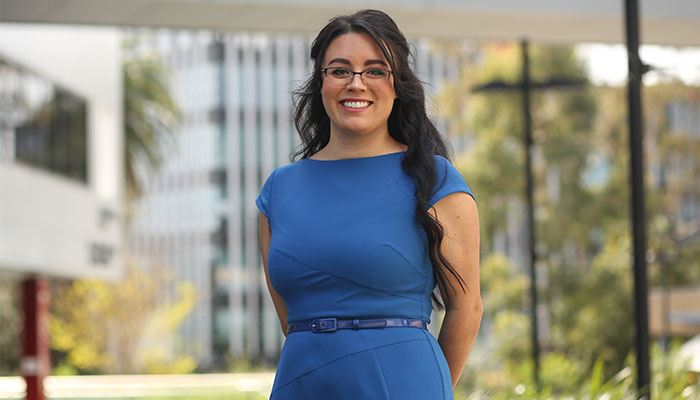This week's Black Friday sales mark the start of the festive sales season. The Australian Retailers’ Association and Roy Morgan predict that Australians will spend a staggering $53 billion between November 14 and December 25.

Part of the herd: When we see others line up in long sales queues, crowd around sales tables or walk away with armfuls of bags, we are drawn to join in the craze, says Associate Professor Jana Bowden.
Originally a derogatory term to describe the shopper chaos in America the day after Thanksgiving, today it has spread beyond the US and represents the day in which shoppers, globally, are guaranteed to find a bargain.
Shopping Splurge
But Black Friday isn’t just reserved for bricks-and-mortar retail - sales fever has also swept through online retail outlets and it has cemented Black Friday as one of the biggest shopping events of the year. A recent survey found that 71 per cent of our population, or 13.8 million Australians, are expected to swipe their credit cards and cough up cash at the checkout this week.
Online retailers are the big winners of the Black Friday sales, with added sales from Cyber Monday, which falls on the following Monday. Last year, sales for the two events totalled $400 million in Australia.
This year, Black Friday sales are expected to contribute strongly to a total November shopping splurge of $3.9 billion.
In the lead up to this shopping bonanza, online search interest is also up. Google Trends data shows that internet traffic searching for ‘Black Friday’ in Australia has been increasing rapidly since mid-October. Related consumer keyword searches have also increased, according to Google Trends.
December is no longer the peak spend period for festive shopping. Large scale global events like Black Friday and Cyber Monday have brought the spend curve forward.
The hottest product categories this year are tech brands and products which are leading the category search online with fashion retail, travel, gadgets and home decor products trailing closely behind. While Black Friday has a broad market attraction, Gen Z and Gen Y are driving consumer buzz.
What about Christmas?
December is no longer the peak spend period for festive shopping. Consumers now take advantage of the deep discounts and deals offered in November during the four-day stretch from Black Friday, through to Cyber Monday.
Christmas is still a drawcard for shoppers, and it remains an important social shopping opportunity. However, large-scale global events like Black Friday and Cyber Monday have brought the spend curve forward and consumers are increasingly savvy about their purchasing.
In 2017 for example, retail sales surged by 1.2 per cent in November and then declined by 0.5 per cent in December reflecting the impact of Black Friday sales.

Psychology: Fear of missing out is a basic driver of consumers’ shopping urges and it underlies impulse purchasing, says Bowden.
Bargain hunting consumers are chasing savings and retailers are keen to compete not only on price and margin but also on added value and product bunding.
This method is being offered by a large makeup chain which is enticing consumers in with discounts, and limited edition Black Friday kits to increase spending and encourage ‘gifting’ traffic. Where Black Friday used to be a standalone, primarily online shopping event, it is now a multichannel event and launchpad to whet consumers’ appetite and get them in the spending mood for Christmas.
Rampant Consumers
According to Adobe Analytics, which tracks transactions for the Top 100 US internet retailers, Black Friday brought in $US6 billion in online sales last year, but it’s not just America that is the top spot for Black Friday deals. Other countries like Brazil, France, Germany and Australia have seen significant growth in interest in the sales trend.
In fact, Australia now ranks 17th globally in Black Friday online keyword search volume. Finder reports that consumer interest in Black Friday-related search online has increased by 22 per cent when compared to 2018 figures. It has also increased fourfold since 2014.
While retail spending has been flat over recent quarters – the ABS reported only a 0.4 per cent increase in spending in August – Black Friday is still one of the biggest sales days for Australian retail.
‘FOMO’ and the psychology of behaviour
Psychology can tell us a lot about why consumers get caught up in the Black Friday frenzy.
FOMO, or Fear of Missing Out, is a basic driver of consumers’ shopping urges and it underlies impulse purchasing. It is characterised by a consumer’s desire to stay constantly connected with other consumers and brands in order to know what they are doing.
While we may not like to admit it, many of us are susceptible to the pull of retailers’ sales strategies – and Black Friday. The allure of a branded global sales banner and a bargain leads to increased purchase anxiety, enhances consumer vulnerability and promotes a state of psychological, self-regulatory limbo, dissonance and flux.
From a consumption perspective, FOMO fuels thought occupancy, obsession and addiction – the perfect storm for consumer overspending.

December downturn: Retail sales surged by 1.2 per cent in November 2017 says Bowden, and then declined by 0.5 per cent in December reflecting the impact of Black Friday sales.
The Halo Effect
The halo effect occurs when a consumer notices an exceptional bargain for the desired item.
A classic retail baiting strategy, it reflects the tendency of consumers to generalise the one exceptional sales deal to all other sales, while reducing their sensitivity to variations in discount levels for other product offers.
It draws consumers interest, reduces consumer scepticism, creates excitement and encourages additional spend.
For instance, one great sales deal creates the perception in consumers’ minds that all of the retailer’s other products are also bargains. As a retail strategy, it’s about promoting products at a discount that drive sales of other higher-margin products. From the consumer’s perspective it means that consumers have difficulty psychologically discriminating between deals as they get swept up in the sales frenzy and excitement.
Herding Effect
Basic consumer need models (and evolution) tell us that we like to belong. We find comfort in numbers and in feeling that we have commonality with those around us – the “just like me” phenomenon.
When we see others line up in long sales queues, crowd around sales tables, or walk away with armfuls of bags, we are drawn to join in the craze. Crowds attract more crowds, and more crowds create more buzz.
Consumers let their guard down as others rush to spend up big. Post-purchase dissonance, remorse and guilt about expenditure are reduced as other consumers consume. As a result, consumers are likely to spend more. Somewhat irrationally, herding fosters social cohesion and, depending on how you look at it, it becomes much easier to become trapped in a vicious spending cycle.
At the most fundamental level, Black Friday craze triggers our deepest emotional, social, cognitive and behavioural responses – the four classic, psychological pillars of consumer engagement.
The sales proposition is tantalising, all-consuming, and it can irresistibly lead us down the path to overspending. But by considering the psychology behind our decision-making and our behaviour, we can take a step back, evaluate our actions and rationally attempt to maximise the value that Black Friday has to offer.
Associate Professor Jana Bowden is a research specialist in the area of retail marketing, consumer engagement and consumer behaviour in the Department of Marketing, Macquarie Business School, Macquarie University.



